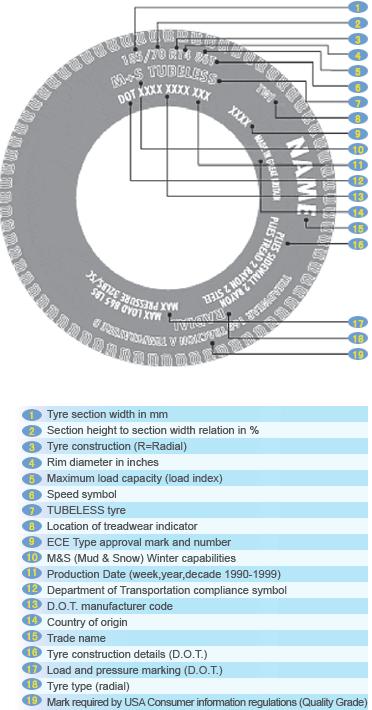What damages tyres?
Understanding your tyre size will make the selection of your next tyres a lot quicker and easier. Tyre size contains information pertaining to its manufacturer, size, model etc. You can find this information on the sidewall of your tyre and it will read something like: 195/55 R16 87V. The following is an explanation of all terminology used for both regular and low profile tyres.

Nominal Section Width:
Aspect Ratio: Construction: Rim Diameter: Load And Speed Index

Glossary of Terms
- Tyre Type defines the proper use of the tyre. “P” means this is a Passenger car tyre. If the tyre had an “LT” then the tyre would be for a Light Truck.
- Tyre Width is the width of the tyre measured in millimetres from sidewall to sidewall. This tyre is 215 millimetres.
- Aspect Ratio is the ratio of the height of the tyre’s cross-section to its width. 65 means that the height is equal to 65% of the tyre’s width.
- Construction tells you how the tyre was put together. The “R” stands for radial, which means that the body ply cords, which are layers of fabric that make up the body of the tyre, run radially across the tyre from bead to bead. “B” indicates the tyre is of bias construction, meaning that the body ply cords run diagonally across the tyre from bead to bead, with the ply layers alternating in direction to reinforce one another.
- Wheel Diameter is the width of the wheel from one end to the other. The diameter of this wheel is 15 inches.
- Load Index is a number that corresponds to the maximum load in kilograms that a tyre can support when properly inflated. You will also find the maximum load in pounds and in kilograms moulded elsewhere on the tyre sidewall.

- Speed Rating is a number that corresponds to the maximum service speed for a tyre. “H” means that the tyre has a maximum service speed of 210 km/h. Please note that this rating relates only to tyre speed capability, and is NOT a recommendation to exceed legally posted speed limits; always drive within the legal speed limits.
- Speed symbol on your Tyre. It is very important that you check your speed symbols before buying your tyres. Even when you are replacing your vehicle’s tyres it is important to ensure the new tyres, even if they are of a different size, have the same or a higher speed symbol. Speed symbol determines the maximum speed at which it can carry its rated load. For the illustrated tyre in the above section, the symbol V limits its maximum speed to 240 km/h. Likewise, there are other speed symbols, whose related speeds can be viewed in the table below.
Load Index on your Tyre.
The number following the rim diameter indicates the maximum load that the tyre can carry. Usually a rough load estimate of a tyre is determined by dividing the total load capacity of the vehicle by four and checking the result (Total Load Carrying Capacity) for the associated load index in the table below. Some vehicles require tyres that are rated to carry a higher load and therefore have a higher inflation pressure. This information is contained in the manufacturer’s handbook and the tyres will carry the marking RF (Reinforced) or XL (Extra Load).

- “DOT” means the tyre is compliant with all applicable safety standards established by the U.S. Department of Transportation (DOT). Adjacent to this is a tyre identification or serial number; a combination of numbers and letters with up to 12 digits.
- “UTQG” stands for Uniform Tyre Quality Grading, a quality rating system developed by the Department of Transportation (DOT).
Tyre Grades: Uniform Tyre Quality Grading System or UTQG
Except for snow tyres, the DOT requires the manufacturers to grade passenger car tyres based on three performance factors: tread wear, traction, and temperature resistance. The UTQG rating of each Goodyear passenger car and light truck tyre is listed in the Car/Light Truck Tyre Catalogue.
Tread Wear
- More Than 100 – Better
- 100 – Baseline
- Less Than 100 – Poorer
The tread wear grade is a comparative rating based on the wear rate of the tyre when tested under controlled conditions on a specified government test track. A tyre graded 200 would wear twice as long on the government test track as one graded 100. Your actual tyre mileage depends upon the conditions of their use and may vary due to driving habits, service practices, differences in road characteristics and climate. Note: Tread wear grades are valid only for comparisons within a manufacturer’s product line. They are not valid for comparisons between manufacturers.
Traction
- A – Best
- B – Intermediate
- C – Acceptable
Traction grades represent the tyre’s ability to stop on wet pavement as measured under controlled conditions on specified government test surfaces of asphalt and concrete. The Traction grade is based upon “straight ahead” braking tests; it does not indicate cornering ability.
Temperature
- A – Best
- B – Intermediate
- C – Acceptable
The temperature grades represent the tyre’s resistance to the generation of heat when tested under controlled conditions on a specified indoor laboratory test wheel. Sustained high temperatures can cause the materials of the tyre to degenerate and thus reduce tyre life. Excessive temperatures can lead to tyre failure.




